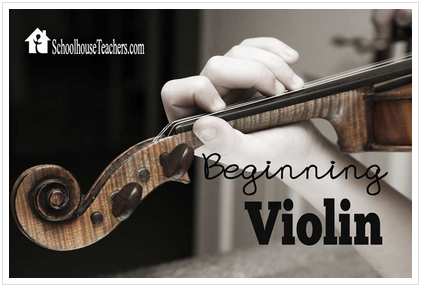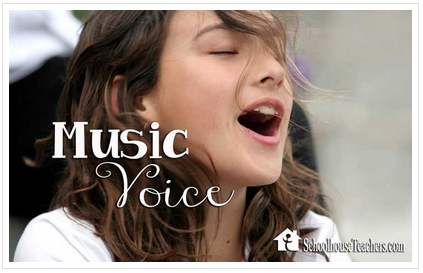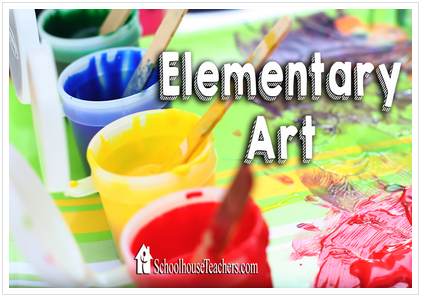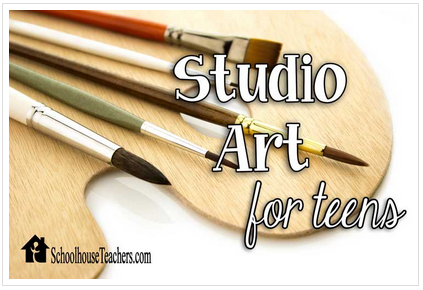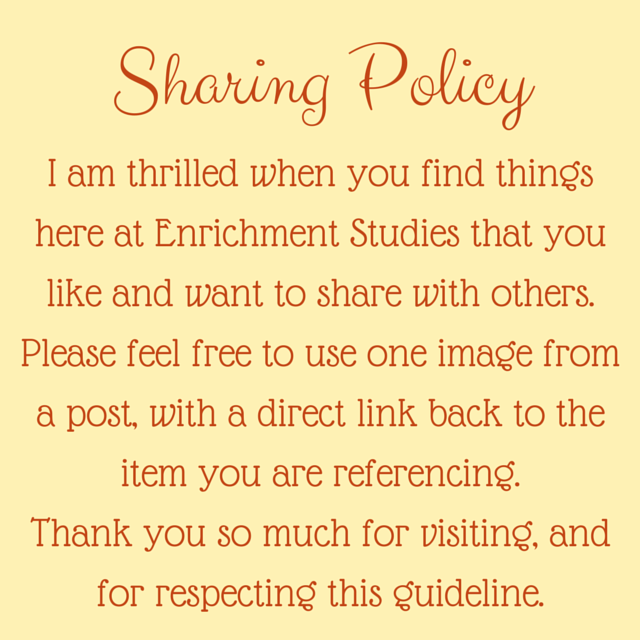by Erica Johns | Mar 16, 2019 | Art, Freebies
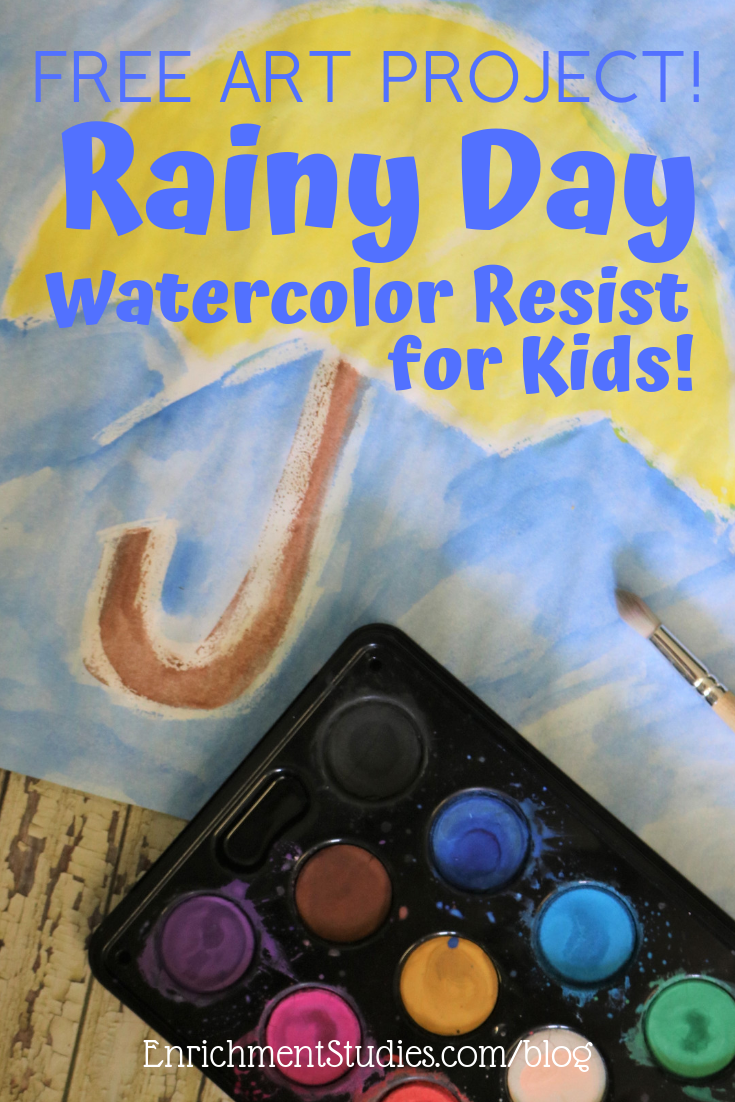 If you have done art with kids at all, whether it be to a group, or to your own kids for homeschool art, or just as a fun activity, watercolors are something you have probably done more than once. Kids learn to use them at a very young age and because of the way they are packaged, all neat and dry in their own little containers, they make it easy to transport and use other places, too. You just need some watercolor paper, water and a brush, and you’ve got something fun to do.
If you have done art with kids at all, whether it be to a group, or to your own kids for homeschool art, or just as a fun activity, watercolors are something you have probably done more than once. Kids learn to use them at a very young age and because of the way they are packaged, all neat and dry in their own little containers, they make it easy to transport and use other places, too. You just need some watercolor paper, water and a brush, and you’ve got something fun to do.
For this project, the only other thing you need is a white crayon!
Watercolor resist is a technique where you draw a fairly simple design on your paper first, and the wax from the crayon “resists” the water and paint pigment, creating a neat look that is a magical thing to watch, too, so kids really enjoy it.
For this specific artwork, I was thinking for a rainy day activity, or during the summer when it can tend to be umbrella season, but truly, it is good for anytime. Amazon affiliate links have been used for some of the recommended supplies.
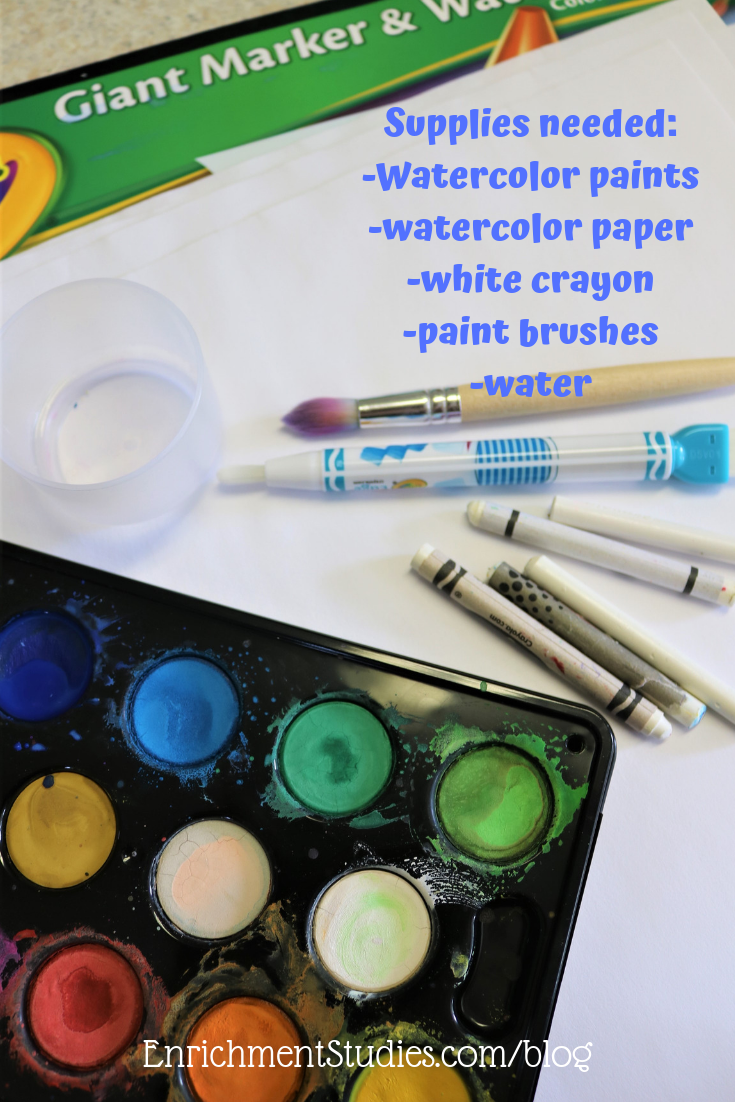 What you will need:
What you will need:
Watercolor paper: Yes, it really does make a difference to have the right paper. Regular paper gets soggy, rips and tears, and crinkles up when drying. Watercolor paper will give a much better outcome. One or two sheets per child.
Watercolor paints: I love this set for the vibrant colors, good coverage, and quality. SO much better than cheapie sets.
Brushes: A medium to large brush and a small brush for each child. I recommend this set of brushes because of the amount, variety of sizes, and quality.
White crayon – 1 per child
Cup of water and paper towels for each child
Hand wipes or a damp washcloth
Directions:
- Drawing the design: First thing, depending on the age of the kids, you may want to pre-draw the outline of the umbrella design for them with the white crayon. For kids maybe 3rd grade and under, this helps them get to experience the “magic” of seeing the white outline pop through the paint.Middlers (like 3rd-5th grade) may enjoy doing it once with you pre-drawing, and then a second time on their own once they’ve learned the technique. For older kids who you feel can design their own artwork easily, give them the crayons first and allow them to draw their own and then paint it. You can give them the theme of rainy day – I gave them summer rain, or something like that and they all came up with neat weather related paintings. It doesn’t have to be an umbrella. 🙂

This is a very poorly done outline of what the white crayon design should be like on your paper. #humble
The crayon is a little hard to see when you begin, but if you tilt the paper in the light, it will reflect the light and it will be easier to see. Start out by drawing the umbrella top, since it is the most focal and large part of the painting, and go over the lines several times with the crayon. If you don’t make the lines nice and thick in crayon, it won’t resist the paint. Then, draw your handle and some rain drops in the same manner.
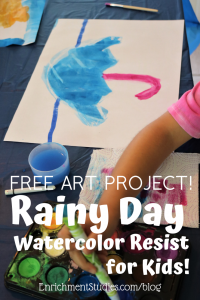 2. Painting: Now, give the kids the paints and brushes and water, and let them color in their umbrellas and skies. I told them to think “rainy day” or stormy type of skies, but I let them do it the way they wanted, and they all came out awesome.
2. Painting: Now, give the kids the paints and brushes and water, and let them color in their umbrellas and skies. I told them to think “rainy day” or stormy type of skies, but I let them do it the way they wanted, and they all came out awesome.
If they are newer to watercolors, they may try to make the paints thick, the way they are used to seeing acrylics or other mediums, and if they go too thick, the water won’t repel off the wax, so try to explain to them that you want strong color, but you do need it to be wet and spread it around some, so the water shows through. I had a few who didn’t really grasp the concept and they painted it very thick, so hardly any white popped through. (They still painted beautiful pieces though!)
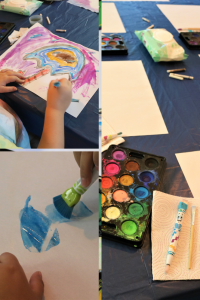

3. Drying: Once they are done with the watercolor paints, just allow them about 15 to 20 minutes to dry all the way.
Once you know how to make watercolor relief work, you can use it in lots of different ways!
by Erica Johns | Jan 11, 2019 | Art
Daily Art is our super popular done-for-you art appreciation program that comes to you via email.
One of the fun things about this program is that there are some suggested art projects included. Most are pretty easy to do at home with items you probably already have around, but just in case you need to fill in the gaps, I’ve made up a list of the tools and supplies that we use here and have found worthwhile.
Not being a natural artist myself, it took my until I was an adult to discover the huge difference that having quality materials makes in creating art. If you have paint colors that are thin and weak, brushes that shed bristles, and paper that falls apart, painting isn’t much fun! Once I got introduced to The Good Stuff my enjoyment of creating things went way up. And best of all, these items really aren’t expensive. It’s more a matter of knowing what’s worth getting.
Here are links to the recommended items for following along with the art projects included in Daily Art: Renaissance. Amazon affiliate links are used.
watercolor paints: This set gives vibrant colors that I absolutely love! SO much better than those weak little trays of blah that most of us have had. Quality matters so much and these will inspire and delight your kids at a very reasonable price.
watercolor paper: Yes, you need watercolor paper, not regular paper. Watercolor paper provides a thickness that can stand up to the wetness of watercolors without tearing, warping, and soaking through. Having the right materials makes a big difference in how much your children will enjoy art.
paint brushes: I love this set both for quality and variety. You get 12 different brushes in this set, so there’s enough for a few kids to share. Better yet–they are junky and won’t lose bristles left and right like others do. They hold up nicely to washing after use, and store in their own zip pouch.
acrylic paint set: I like this set of washable paints because you get 18 different colors in 2 ounce bottles, so it’s plenty for kids to share and to cover just about any painting project your little artists will want to do. I also like the box it comes in, which still serves as storage for my set 4 years after I bought it.
colored pencils: Invest in one high-quality colored pencils set that’s large enough for your children to share, and stores in it’s own tin box! These can’t be beat for great saturated color, smoothness going on paper, thick leads so they don’t break every five minutes, and nice ability for shading and blending. Get as large a set as you can afford. They are so nice!
brayer/paint roller: Easy to use, easy to clean. You can get one or two and have the kids share.
clay tools: For Daily Art: Renaissance, you can get away with using dull pencils, toothpicks, or sticks. But if you have kids that like to do more precise work, and if you don’t already have some tools for clay or sculpey around, you might enjoy this set. I like it that they are double sided, so you get 12 tools in one set. Beware, some are sharp!
regular pencils and paper
crayons
markers
Ivory soap: grocery store pickup
styrofoam plates: grocery store pickup
permanent markers like sharpie (regular and a thin tip black one)
old toothbrush
paper plates
by Erica Johns | Aug 19, 2018 | Art, Great Stuff for Homeschool Moms, History
Giveaway!
We are giving away one Take Time for Art course PLUS an art materials pack! (click here to see the options)
Value: $95 plus free shipping
Must have an address in the 48 contiguous United States to win.
Other goodies:
Sign up for their newsletter and get a coupon for 20% off! (sign up is at the bottom of the screen when on desktop) Coupon is good through May 7, 2021.
FREE SHIPPING at checkout anytime you buy 3 art materials packs!
FREE TRIAL: Wondering if your kids will love it? You can try out Take Time for Art video curriculum for free for a week. Just sign up for the All Access Subscription Plan and get a free week. If it’s not for you, you can cancel before the week is up and you won’t be charged! Click here for more information.
FREE CLASSES! Take Time for Art also offers some free classes. There’s one about the color wheel, another about Feudalism and the Lewis Chessmen, and Roman Roads with the story of the conversion of Paul. Click here to sign up.
My review is below, but if you’re looking for even more reviews, check them out here.
By entering this giveaway you are agreeing to have your email address shared with Take Time for Art and Enrichment Studies, and may be contacted in the future with relevant home education emails.
 One of the very best ways to help our kids get excited about history and remember what they’ve learned is by making meaningful connections. Take Time for Art does an awesome job of doing just that, by bringing together audio, video, visuals, and really cool art projects into one fabulous program that makes history study so exciting and accessible!
One of the very best ways to help our kids get excited about history and remember what they’ve learned is by making meaningful connections. Take Time for Art does an awesome job of doing just that, by bringing together audio, video, visuals, and really cool art projects into one fabulous program that makes history study so exciting and accessible!
About a year ago I got to meet Take Time for Art founder Penny Mayes, and I was so excited to hear about the way she has combined art and history into a program that I know other homeschool families will love.
My teenage sons and I got to work through the Ancient Greece program at Take Time for Art. (They also offer Ancient Egypt, Ancient Rome, Middle Ages, and Renaissance) In this program we got to watch 15 different well-done streaming videos that taught us about various aspects of Ancient Greece, such as the ancient Minoans, the Mycenean civilization, the dark ages, Athens, the Hellenistic period, and several forms of art such as metal tooling, fresco paintings, pottery, wartime clothing, and more. Each section of history is followed by an art project that’s inspired by that era. The video walks you through each step of the process of creating the art, and the convenient art supplies pack contained all the materials we needed in order to complete the projects. (except for a few basic items that you would be sure to have on hand)
For the Ancient Greece program we got to make the following projects:
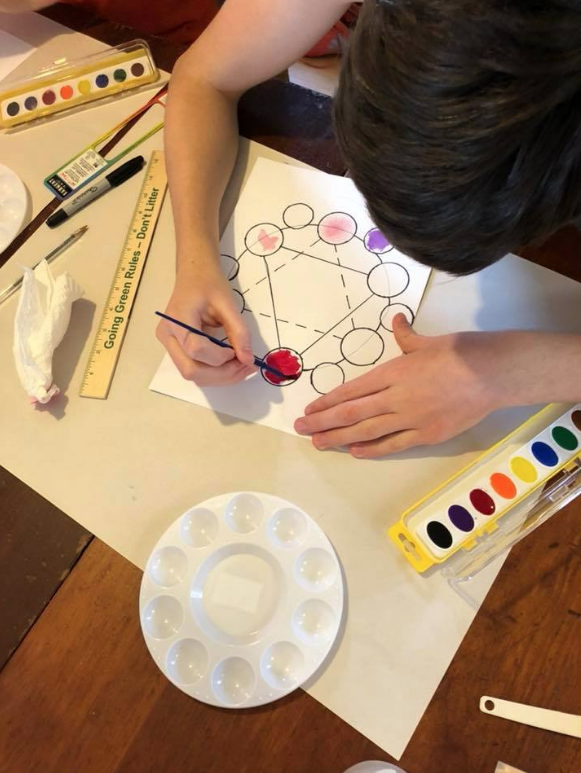
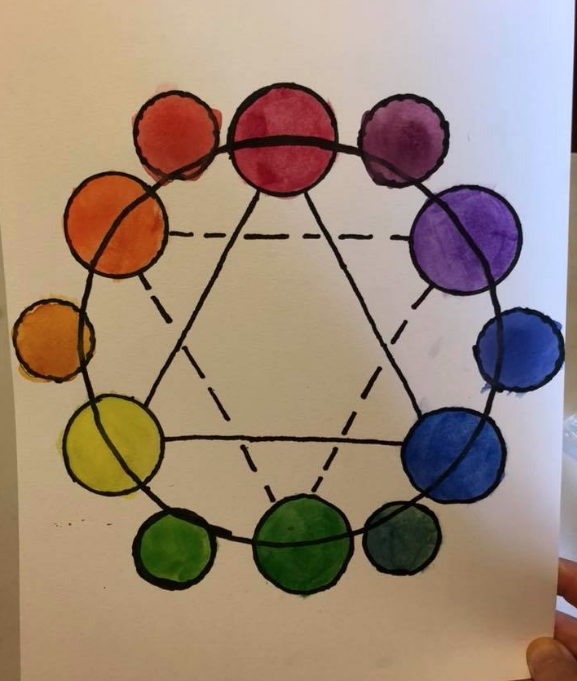
- a color wheel (which is referred back to in later projects–a great starting point for understanding the relationships between colors!)
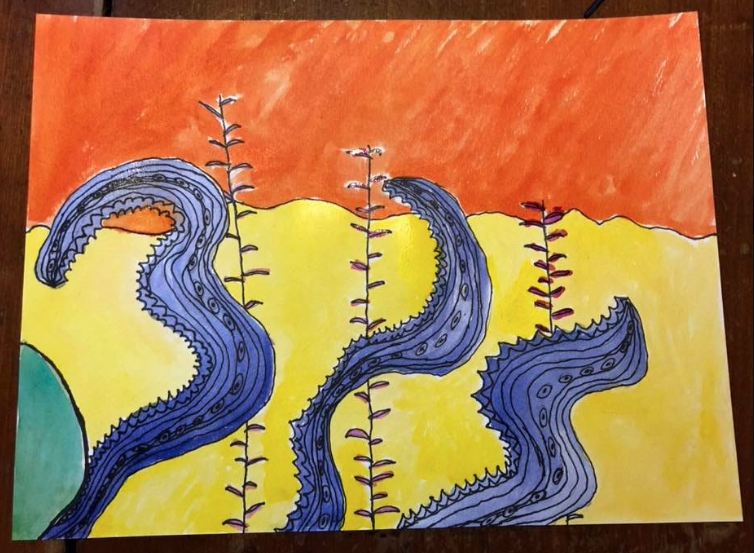
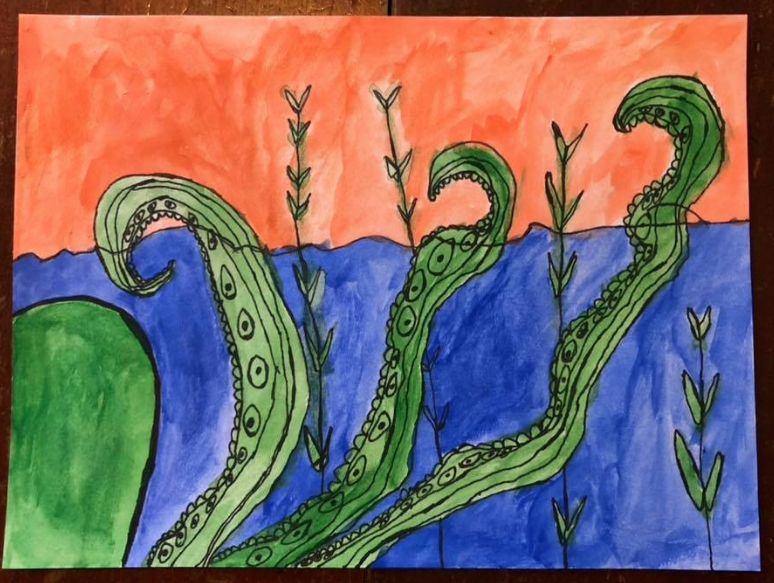
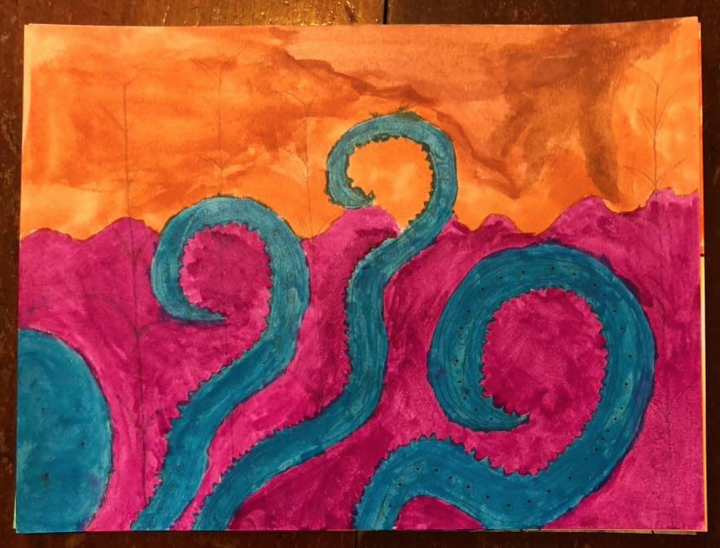
- a watercolor fresco painting of an octopus
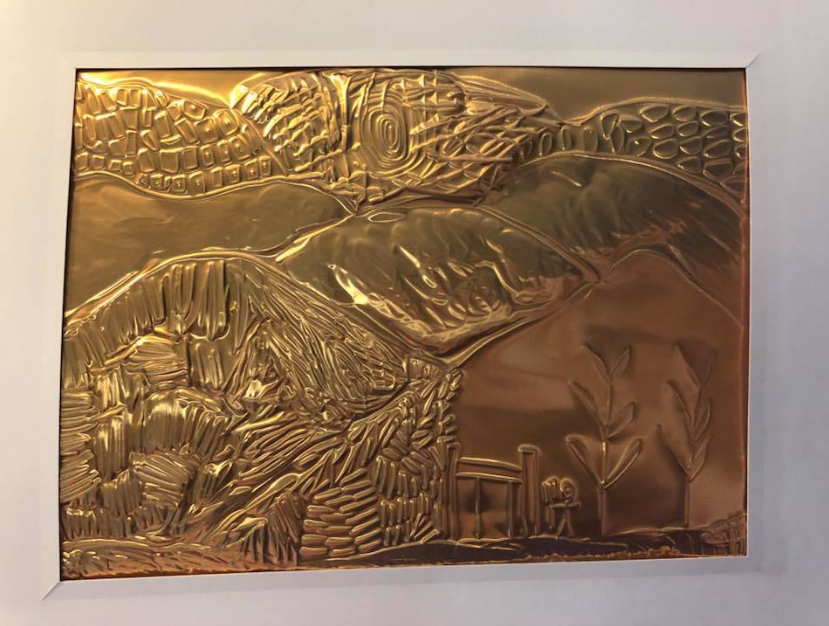

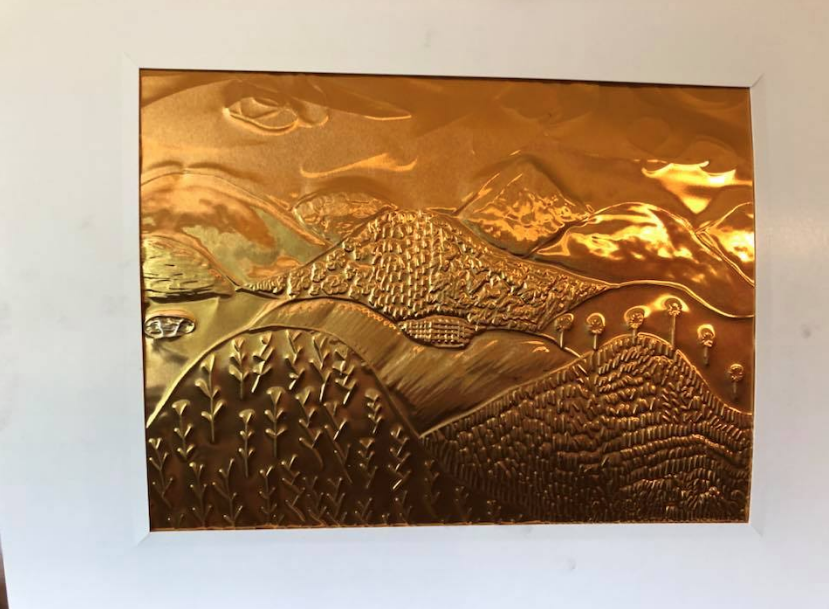
- a metal tooling landscape project (the other option was to make a Mask of Agamemnon, which was also super cool. But we fell in love with these textures and all selected the landscape project. They are so pretty in person!)


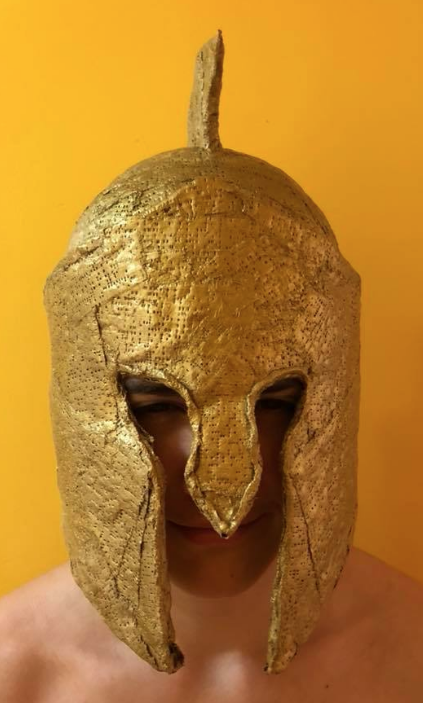
a Greek warrior helmet (we had the option to make it with or without a crest and other adornments. It is really cool, and yes, you can even wear your finished helmet!)

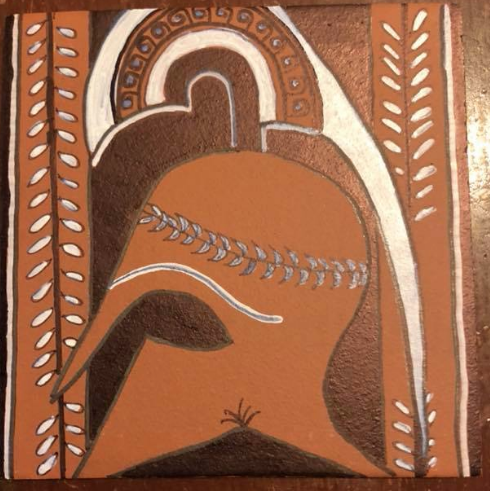
- a terra cotta tile art project that I really enjoyed! I have never worked with terra cotta tiles, and I liked the surface and the way the marker color sinks into the surface. We could have chosen a horse image for the tile as well. Bonus fun was that we were able to heat this in our oven for 30 minutes, which makes the artwork on it longer-lasting!
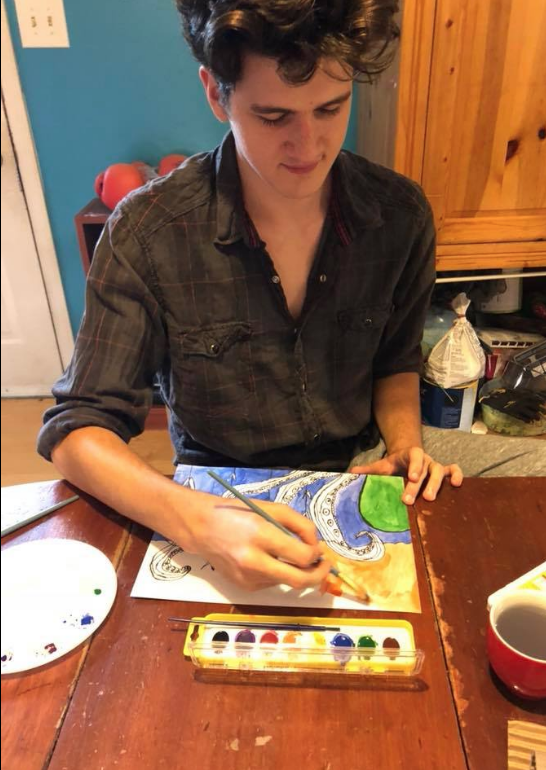 One of the things I really like about this program is the variety of projects available. Within this one program we got to learn a lot of history while also trying out several completely different types of art that we would not have thought up on our own. Even better, within each project there are choices, sometimes an either-or option, sometimes an easier/more difficult option. I love it that this gives the kids options and allows them to choose the thing they are most excited about. This is also great because the program will work for the typical homeschool family that has many different ages of children represented in their family. Middle elementary kids could certainly do these projects with some assistance, but there is definitely enough challenge for high schoolers and parents to participate as well! I personally enjoyed doing some of the projects myself, and got to learn about art materials that I had never worked with before.
One of the things I really like about this program is the variety of projects available. Within this one program we got to learn a lot of history while also trying out several completely different types of art that we would not have thought up on our own. Even better, within each project there are choices, sometimes an either-or option, sometimes an easier/more difficult option. I love it that this gives the kids options and allows them to choose the thing they are most excited about. This is also great because the program will work for the typical homeschool family that has many different ages of children represented in their family. Middle elementary kids could certainly do these projects with some assistance, but there is definitely enough challenge for high schoolers and parents to participate as well! I personally enjoyed doing some of the projects myself, and got to learn about art materials that I had never worked with before.
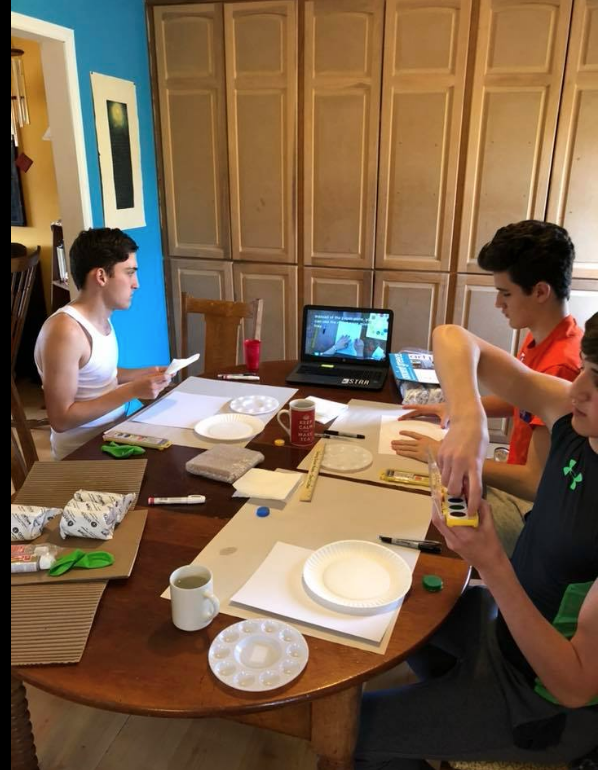 The other thing I love about this is that the projects are guided. Sure, total creativity is exciting and cool, but not everybody’s mind works like that. Participating in a guided art activity gives us the opportunity to work with materials and techniques that we may not be familiar with, and offers a jumping off point for future creative endeavors. I am solidly in the camp of believing that BOTH guided art experiences AND free time to create art are valuable. (for parents and kids alike!)
The other thing I love about this is that the projects are guided. Sure, total creativity is exciting and cool, but not everybody’s mind works like that. Participating in a guided art activity gives us the opportunity to work with materials and techniques that we may not be familiar with, and offers a jumping off point for future creative endeavors. I am solidly in the camp of believing that BOTH guided art experiences AND free time to create art are valuable. (for parents and kids alike!)
These are not fluff projects. Each one is meaty, involved, takes several hours to complete (some are done over the course of more than one day), and produces a very nice piece of finished work for you to enjoy. Your kids will be proud of their art work!
 Budget-conscious moms may be tempted to wonder if they really need a separate art supply pack for each child. You will definitely want to get one per person. Sure, there are a couple items included that could possibly be shared between kids, but for the most part each person will need all the supplies provided, and it will be less confusing and complicated when everybody has all the materials they need. I really appreciated how organized the art supplies kit was, how carefully the bendable items were packaged and protected, and that having all of it together made it possible for us to actually do these projects. If I had needed to track down all the materials from the store, or worry about dividing them up between several children, that would probably have been enough of a barrier to make me not get it done. Take Time for Art has made it about a simple as possible to watch the streaming videos and complete the projects! Perfect for busy homeschool families.
Budget-conscious moms may be tempted to wonder if they really need a separate art supply pack for each child. You will definitely want to get one per person. Sure, there are a couple items included that could possibly be shared between kids, but for the most part each person will need all the supplies provided, and it will be less confusing and complicated when everybody has all the materials they need. I really appreciated how organized the art supplies kit was, how carefully the bendable items were packaged and protected, and that having all of it together made it possible for us to actually do these projects. If I had needed to track down all the materials from the store, or worry about dividing them up between several children, that would probably have been enough of a barrier to make me not get it done. Take Time for Art has made it about a simple as possible to watch the streaming videos and complete the projects! Perfect for busy homeschool families.
I can see Take Time for Art being a wonderful addition to your more formal studies about the coordinating time period. I think it would work well as a once-a-week or twice a month supplement and reinforcement where you would watch one of the history videos, and then work on the next art project. Your kids will love the change of pace, plus they’ll have some really cool finished projects to display in their bedrooms or in your home that will also help them recall the time period and historical information related to the piece.
Click here to visit Take Time for Art and check out their programs!
by Erica Johns | May 25, 2018 | Art, Fine Arts Friday
I’m sure you’ve heard how arts education is being cut from school budgets all over the US. For many home educators, this is one of the things they appreciate so much about the freedom they have to prioritize educational and enrichment opportunities for their children. I was contacted by Neve Spicer, founder of We The Parents, and she was kind enough to share this short article and her infographic with us.
~Erica

Arts Education in schools is being backed towards a cliff edge.
In a bid to save the Arts, educators are trying to demonstrate that they enhance outcomes in non-art subjects. Yet, while it seems they do, studies rarely prove this beyond all reasonable doubt. The upshot is that, under pressure to funnel dwindling resources into core “academic” subjects (ie, math, literacy, and science), many schools are positioning Arts Education on the chopping block.
It’s time to take a stand!
Firstly, there is growing evidence that learning arts does improve academic achievement. But more importantly, the question must be asked: is the purpose of the Arts Education simply to boost academic results?
Emphatically, no!
Immersed in arts, kids experience the world and themselves in a different way. They often discover a lifelong passion, develop a sense of self and identity, grow in confidence, and envision a world beyond their immediate environment.
It’s vital that we reframe the case for Arts Education.
This visual guide by We The Parents helps to do this by highlighting 51 diverse ways in which Arts Education rewards children. It is clear that learning arts cultivates cognitive abilities, nurtures positive character traits, and fosters critical thinking. As you’ll see, many of the benefits span ages, genders, and socio-economic divides; some last a lifetime; and all are backed up by studies.
There’s never been a more important time to communicate the importance of Arts Education. Scientific studies struggle to capture the subtle yet profound ways in which the arts transform lives. And so, the impetus is on us – we who experience the positive impact first-hand – to share our story and to shout about it even louder.
~Neve Spicer, founder of We The Parents
by Erica Johns | Mar 6, 2018 | Art, Great Stuff for Homeschool Moms, Spring Fling Giveaways
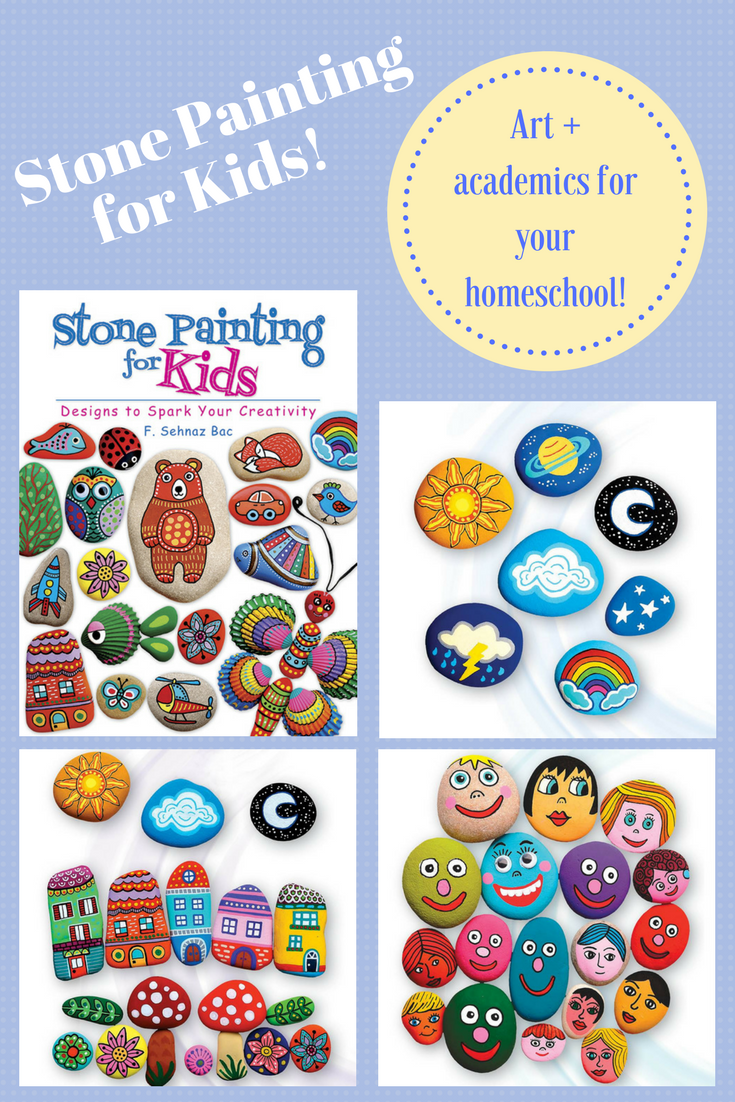
It seems like kids always love arts and crafts, and the new trend of stone painting is super popular and so fun for all ages! What’s more–you can really elevate the crafty side of this activity and use it across all areas of learning! I was incredibly inspired when I got to read through the book Stone Painting for Kids and saw so many possibilities for homeschoolers to mesh the creative with the academic! Read on for lots of creative learning inspiration, sponsored by Dover Publications.
Included in the book are ideas like:
- Geometric shapes (teach your young kids colors and shapes!)
- Numbers (early learning and math opportunities)
- Letters (early reading, spelling, and writing opportunities)
- Hearts
- Faces (including fun cartoon styles that kids will love learning)
- Multi-pebble flowers
- Mushrooms (SO cute!)
- Dominoes (yes! You can make your own dominoes game!)
- Shell painting (fish, butterflies, and more!)
- Chess sets (make your own set and then learn to play!)
- Multi-pebble rabbits and other animals and people
- Words (make sentences, poetry, verses, inspiration pieces, and more!)
- Flowers (combine with your nature studies!)
- Houses and Vehicles (you can make a whole town scene and create vehicles to cruise around!)
- Memory Match game! (perfect for your young kids)
- Sky scenes (including the solar system!)
- Animals of all sorts
- Tic-Tac-Toe game
- Chalkboard paint stones
- Washi taped stones
- Math and counting game ideas
- Storytelling activities
- Spelling games
- Scenes and themes you can make
- and more!
The tons of photos of painted stones and the process to create them are wonderful, and really help you understand the steps you’ll need to take to make something similar yourself. I really like it that stone painting can be as simple as your preschooler would need it to be, but also complex enough to challenge and excite high schoolers and adults.
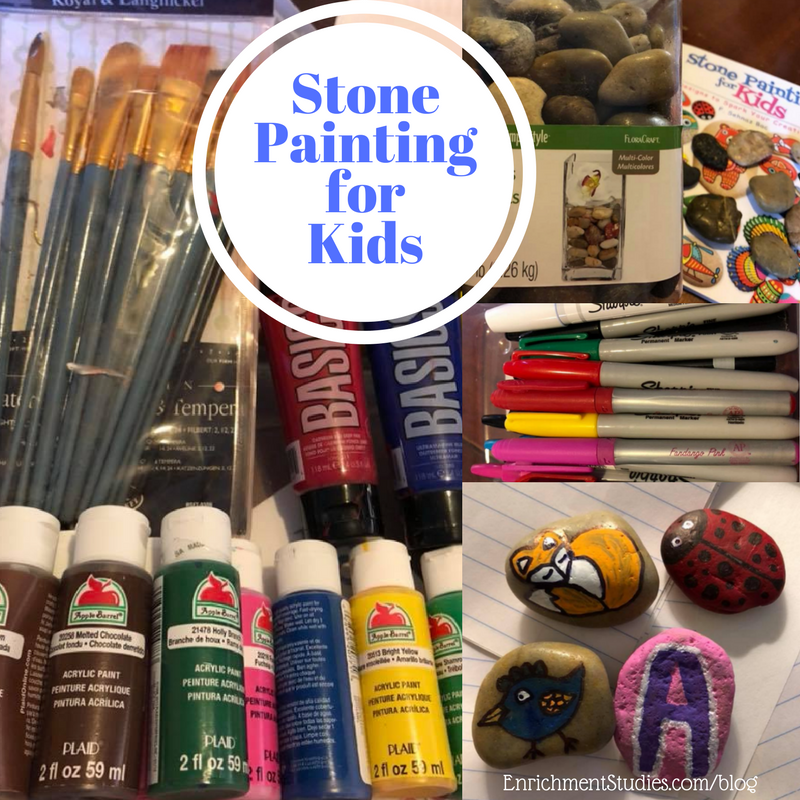 I spent a few enjoyable hours painting stones with the help of this book, and was delighted to see that even someone like me, that doesn’t have great original ideas for thinking something up, could replicate some of these adorable concepts and end up with a fun little treasure to enjoy!
I spent a few enjoyable hours painting stones with the help of this book, and was delighted to see that even someone like me, that doesn’t have great original ideas for thinking something up, could replicate some of these adorable concepts and end up with a fun little treasure to enjoy!
My favorite items that I successfully made were a sleeping fox, a cute birdie, a ladybug, and a pink and purple A to give to my little granddaughter whose name starts with A.
The other thing I super loved about this book is all of the inspiration to enjoy the creative side of this process, but then use the creations in the learning process in your home. Imagine how fun it would be for your kids to paint stones with letters and numbers, and later use those to learn sounds and math! You could work together with your younger children to paint simple stones with just one color per stone, and end up with a wonderful set where you could practice sequencing! For older kids, you could make a solar system set of painted stones, or write out one word per stone from a piece of poetry or Bible verse that you’re memorizing, and enjoy putting them into the right order or creating displays. History lessons can be enhanced by painting stones with homes from different cultures and eras. Nature study can be enjoyed on a rainy or too-cold day by painting stones in ways that remind you of things you’ve seen in your nature walks! Truly, the possibilities are endless, and this book is a wonderful resource for inspiring you and helping you get started.
The author, F. Sehnaz Bac, is a stone paint artist who sells her creations on Etsy, and in this book she takes us by the hand and provides all of the basic advice on how to get started with stone painting, such as choosing stones and preparing them, what materials you can use to paint and decorate them, technique tips, and more. I appreciated that the information in the book was straightforward and to-the-point, and that the step-by-step instructions were helpful without being tedious.
I was pleased to find that art supplies I already had on hand worked great for my stone painting project! The only thing I purchased for this project was a container of craft stones from Walmart for under $5. (They had bags of sea shells available, too!) Other than that, I used the acrylic paints and the paint brushes that I shared about in this post, plus my collection of sharpie markers and a white sharpie paint marker. Easy peasy!
You can connect with Dover Publications at their website, as well as on Facebook, Twitter, and Instagram
Watch my Facebook Live Show & Tell video here:
by Erica Johns | Sep 1, 2017 | Art, Freebies
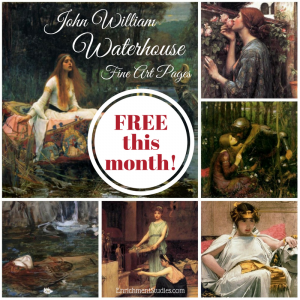 English painter John William Waterhouse is best-known for his portrayals of women in Greek mythology and Arthurian legend. This collection is one of my favorites for drawing together myth, literature, history, and art. You’ll find Cleopatra, The Lady of Shalott, Orpheus, damsels in distress, and more in this Fine Art Pages set.
English painter John William Waterhouse is best-known for his portrayals of women in Greek mythology and Arthurian legend. This collection is one of my favorites for drawing together myth, literature, history, and art. You’ll find Cleopatra, The Lady of Shalott, Orpheus, damsels in distress, and more in this Fine Art Pages set.
Currently you can get it FREE when you sign up at the right —>>> or click here.
 If you have done art with kids at all, whether it be to a group, or to your own kids for homeschool art, or just as a fun activity, watercolors are something you have probably done more than once. Kids learn to use them at a very young age and because of the way they are packaged, all neat and dry in their own little containers, they make it easy to transport and use other places, too. You just need some watercolor paper, water and a brush, and you’ve got something fun to do.
If you have done art with kids at all, whether it be to a group, or to your own kids for homeschool art, or just as a fun activity, watercolors are something you have probably done more than once. Kids learn to use them at a very young age and because of the way they are packaged, all neat and dry in their own little containers, they make it easy to transport and use other places, too. You just need some watercolor paper, water and a brush, and you’ve got something fun to do. What you will need:
What you will need:
 2. Painting: Now, give the kids the paints and brushes and water, and let them color in their umbrellas and skies. I told them to think “rainy day” or stormy type of skies, but I let them do it the way they wanted, and they all came out awesome.
2. Painting: Now, give the kids the paints and brushes and water, and let them color in their umbrellas and skies. I told them to think “rainy day” or stormy type of skies, but I let them do it the way they wanted, and they all came out awesome.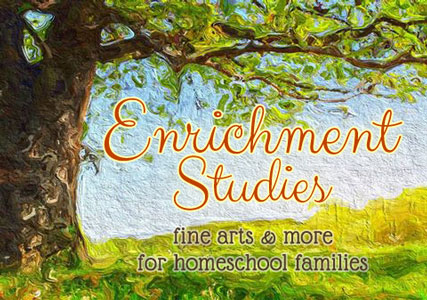

















 One of the things I really like about this program is the variety of projects available. Within this one program we got to learn a lot of history while also trying out several completely different types of art that we would not have thought up on our own. Even better, within each project there are choices, sometimes an either-or option, sometimes an easier/more difficult option. I love it that this gives the kids options and allows them to choose the thing they are most excited about. This is also great because the program will work for the typical homeschool family that has many different ages of children represented in their family. Middle elementary kids could certainly do these projects with some assistance, but there is definitely enough challenge for high schoolers and parents to participate as well! I personally enjoyed doing some of the projects myself, and got to learn about art materials that I had never worked with before.
One of the things I really like about this program is the variety of projects available. Within this one program we got to learn a lot of history while also trying out several completely different types of art that we would not have thought up on our own. Even better, within each project there are choices, sometimes an either-or option, sometimes an easier/more difficult option. I love it that this gives the kids options and allows them to choose the thing they are most excited about. This is also great because the program will work for the typical homeschool family that has many different ages of children represented in their family. Middle elementary kids could certainly do these projects with some assistance, but there is definitely enough challenge for high schoolers and parents to participate as well! I personally enjoyed doing some of the projects myself, and got to learn about art materials that I had never worked with before. The other thing I love about this is that the projects are guided. Sure, total creativity is exciting and cool, but not everybody’s mind works like that. Participating in a guided art activity gives us the opportunity to work with materials and techniques that we may not be familiar with, and offers a jumping off point for future creative endeavors. I am solidly in the camp of believing that BOTH guided art experiences AND free time to create art are valuable. (for parents and kids alike!)
The other thing I love about this is that the projects are guided. Sure, total creativity is exciting and cool, but not everybody’s mind works like that. Participating in a guided art activity gives us the opportunity to work with materials and techniques that we may not be familiar with, and offers a jumping off point for future creative endeavors. I am solidly in the camp of believing that BOTH guided art experiences AND free time to create art are valuable. (for parents and kids alike!) Budget-conscious moms may be tempted to wonder if they really need a separate art supply pack for each child. You will definitely want to get one per person. Sure, there are a couple items included that could possibly be shared between kids, but for the most part each person will need all the supplies provided, and it will be less confusing and complicated when everybody has all the materials they need. I really appreciated how organized the art supplies kit was, how carefully the bendable items were packaged and protected, and that having all of it together made it possible for us to actually do these projects. If I had needed to track down all the materials from the store, or worry about dividing them up between several children, that would probably have been enough of a barrier to make me not get it done. Take Time for Art has made it about a simple as possible to watch the streaming videos and complete the projects! Perfect for busy homeschool families.
Budget-conscious moms may be tempted to wonder if they really need a separate art supply pack for each child. You will definitely want to get one per person. Sure, there are a couple items included that could possibly be shared between kids, but for the most part each person will need all the supplies provided, and it will be less confusing and complicated when everybody has all the materials they need. I really appreciated how organized the art supplies kit was, how carefully the bendable items were packaged and protected, and that having all of it together made it possible for us to actually do these projects. If I had needed to track down all the materials from the store, or worry about dividing them up between several children, that would probably have been enough of a barrier to make me not get it done. Take Time for Art has made it about a simple as possible to watch the streaming videos and complete the projects! Perfect for busy homeschool families.











